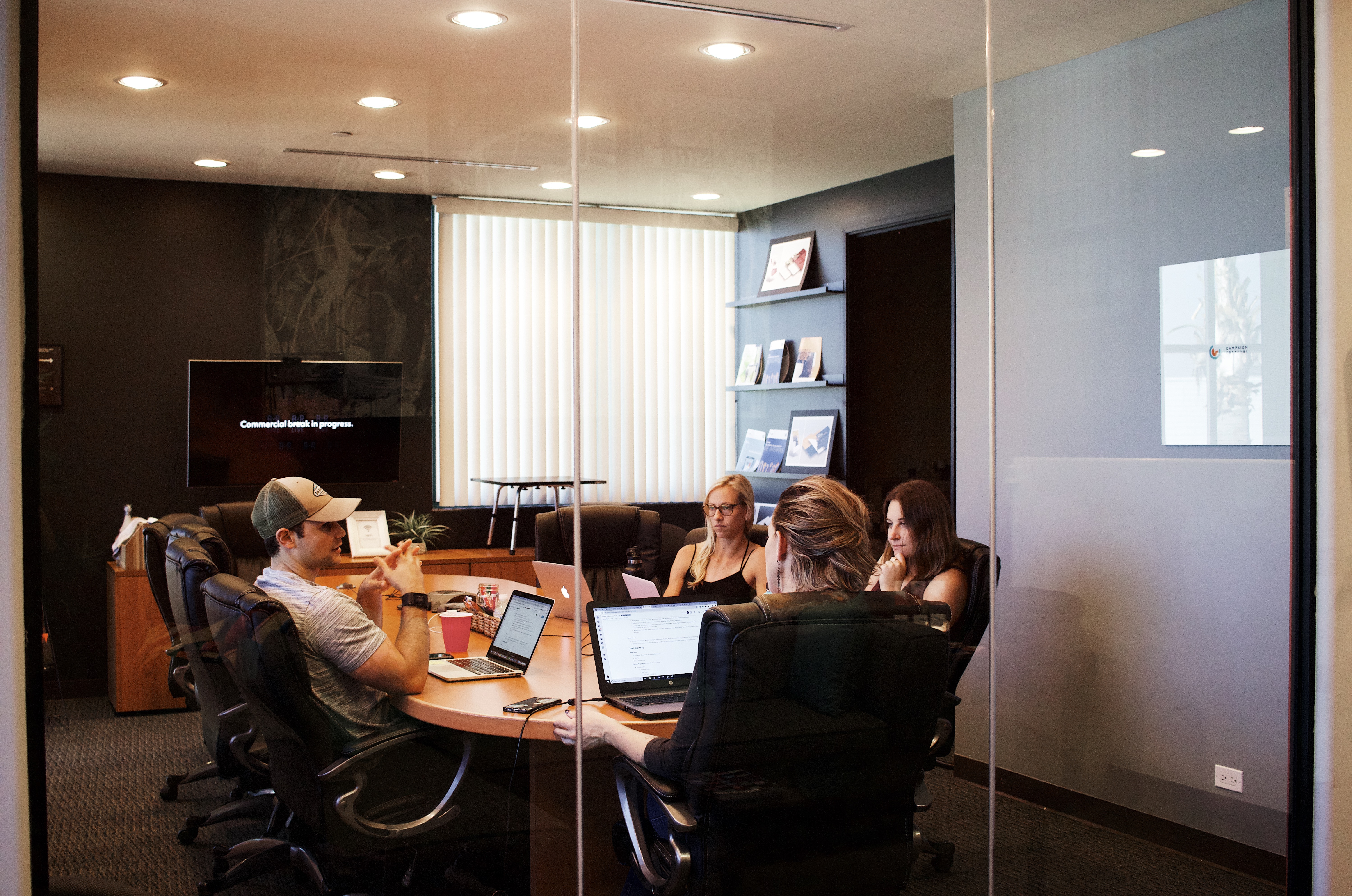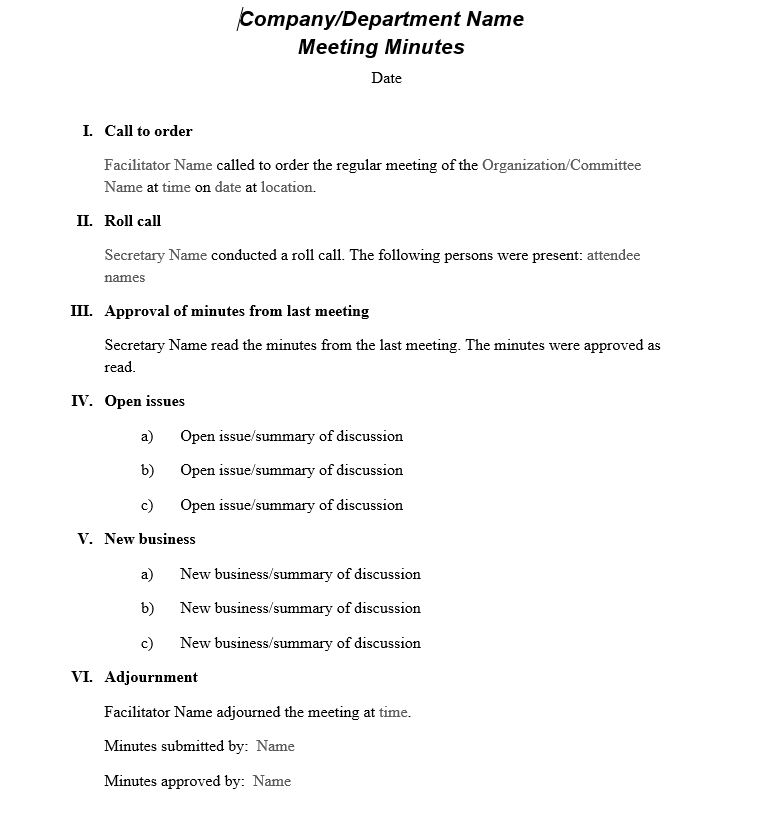7 Meetings and Agendas
katrina webkamigad and Yvonne Abitong

Photo by Campaign Creators on Unsplash
Chapter Objectives
- Create a meeting agenda
- Identify elements of a formal agenda
- Take minutes during a meeting
- Identify elements of formal meeting minutes
AGENDAS
Agendas are used to organize meetings, keep track of old and new content, gives a time frame for what items are to be discussed and provides a clear understanding of a common end goal for the participants. Agendas hold important dates and content, plus they provide guidance and preparations for the following meetings.
What is a meeting Agenda?
- A meeting Agenda is a list of components and goals that participants are to discuss and hope to accomplish during a meeting
What is the purpose of an Agenda?
- To outline the main ideas of any events, responsibilities and deadlines that must be further discussed and determined.
How to Develop an Effective Agenda
- Create an agenda
- Identify the five W’s (Who, What, When, Where and Why?)
- Items of discussion
- Goals of the meeting
- Provide any readings or documentation that will prepare your participants for what is expected
When can an Agenda be used?
- An agenda can be used anytime there is a big event, interview times and dates, work schedules or school schedules, conferences etc.
Agenda
Structure and Format of an Agenda
- Daily Planner
- Timetable
- Syllabus
Running a Meeting
Introduction
Make your objective clear. A meeting must have a specific and defined purpose. Before you send that calendar invite, ask yourself: What do I seek to accomplish? Are you alerting people to a change in management or a shift in strategy? Are you seeking input from others on a problem facing the company? Are you looking to arrive at a decision on a particular matter?
In order to conduct an effective meeting, You also need to have an agenda. An agenda usually contains the following elements:
- Call to Order
- Roll Call
- Reading/Approval of Minutes
- Officer’s (and others) Reports
- Committee Reports
- Unfinished Business
- New Business
Stick to your schedule. Create an agenda that lays out everything you plan to cover in the meeting, along with a timeline that allots a certain number of minutes to each item and email it to people in advance. Once you’re in the meeting, put that agenda up on a screen or whiteboard for others to see. This keeps people focused.
Start on time, end on time. If you have responsibility for running regular meetings and you have a reputation for being someone who starts and ends promptly, you will be amazed how many of your colleagues will make every effort to attend your meetings. People appreciate it when you understand that their time is valuable. Another note on time: Do not schedule any meeting to last longer than an hour. Sixty minutes is generally the longest time workers can remain truly engaged.
Follow up. It’s quite common for people to come away from the same meeting with very different interpretations of what went on. To reduce this risk, email a memo highlighting what was accomplished to all who attended within 24 hours after the meeting. Document the responsibilities given, tasks delegated, and any assigned deadlines. That way, everyone will be on the same page.
MINUTES
Introduction
In this chapter you will be learning the benefits of writing minutes, and what the main purpose of having minutes when attending meetings. When writing minutes it is very important to know how to write minutes, and to make sure you’re doing it in the right format. As you read through this chapter you will gain some very useful knowledge, and hopefully plan to use it in the near future.
What is ‘writing’ Minutes?
When attending a meeting for business purposes, employee purposes, or even a more serious matter such as public meetings with the public population involved. It is very essential that minutes are to be recorded, usually a person is dedicated to take down what is said during this meeting, and what actions were placed before and after the meeting is finished. Minutes is an official workplace document that is to be very important because this is a document that contains what is said during a meeting, who said what during the meeting, and what plans were taken into action as the meeting is continuing on.
What are Minutes used for?
Minutes are used for documenting what happened during a meeting, as well as what was said during the meeting. Minutes are also to inform the attendees who couldn’t make the meeting to be informed what happened during the meeting, and what was discussed during the meeting.
What Elements are included in a Minutes Document?
When writing Minutes for any kind of meeting, there are some standard elements that are to be included in the “Minutes” documentation. To write the proper effective Minutes documentation you are to include;
- The name of Participants.
- The Agenda of the meeting.
- Calendar/Due Dates.
- Actions or Tasks.
- The main points that had been discussed during the meeting.
- Decisions made by the participants.
- Record of what is the most important points of this meeting.
- Future Decisions.
- Documents/images/, attached files.
Before the meeting: The meeting minute recorder must be aware of the different topics to be addressed during the meeting, noting what you know about them in order to save time and to be able to focus on important topics during the meeting. If not, you might end up on the margins of the meeting being too busy taking notes.
During the meeting: meeting minutes are an effective task to a successful meeting, yet they need to be done properly, written and given out to participants as soon as possible. The main problem with writing minutes is that they take a long time to be written down properly, and that they must be sent quickly after the meetings to let everyone know their next projects or actions.
You need to build your notes as the meeting progresses: a good way of organizing your note-taking is to differentiate actions from remarks as well as noting the different actions per person with a deadline.
After the meeting: type out your notes in a logical manner and not chronologically. It needs to be organized to be sent out to your co-workers. Also, adding a short summary organized per person and per project at the end of the minutes helps the attendees who did not attend this meeting to quickly look at the minutes and spot the main points that were discussed during the meeting.

Formal Meeting Minutes template available in Microsoft Office
Informal Meeting Minutes Example
Law Minutes- January 19, 2019
Attendees: Katrina Webkamigad, Sabrina Trudeau
Missing: Yvonne Abitong
Agenda: Discussing about the presentation for Law
Action and Tasks: Discussed the presentation and figure out who’s going to write what and discussed about researching we found and compared each others’ ideas. Also discussed when we would meet up group.
Main Points: Discussing the roles in the group project, discussing the topic of the Ombudsman, giving task/responsibilities on who will research what.
Future Decisions: next meeting we will discuss what everyone researched on, and get started on the powerpoint to input our information.

